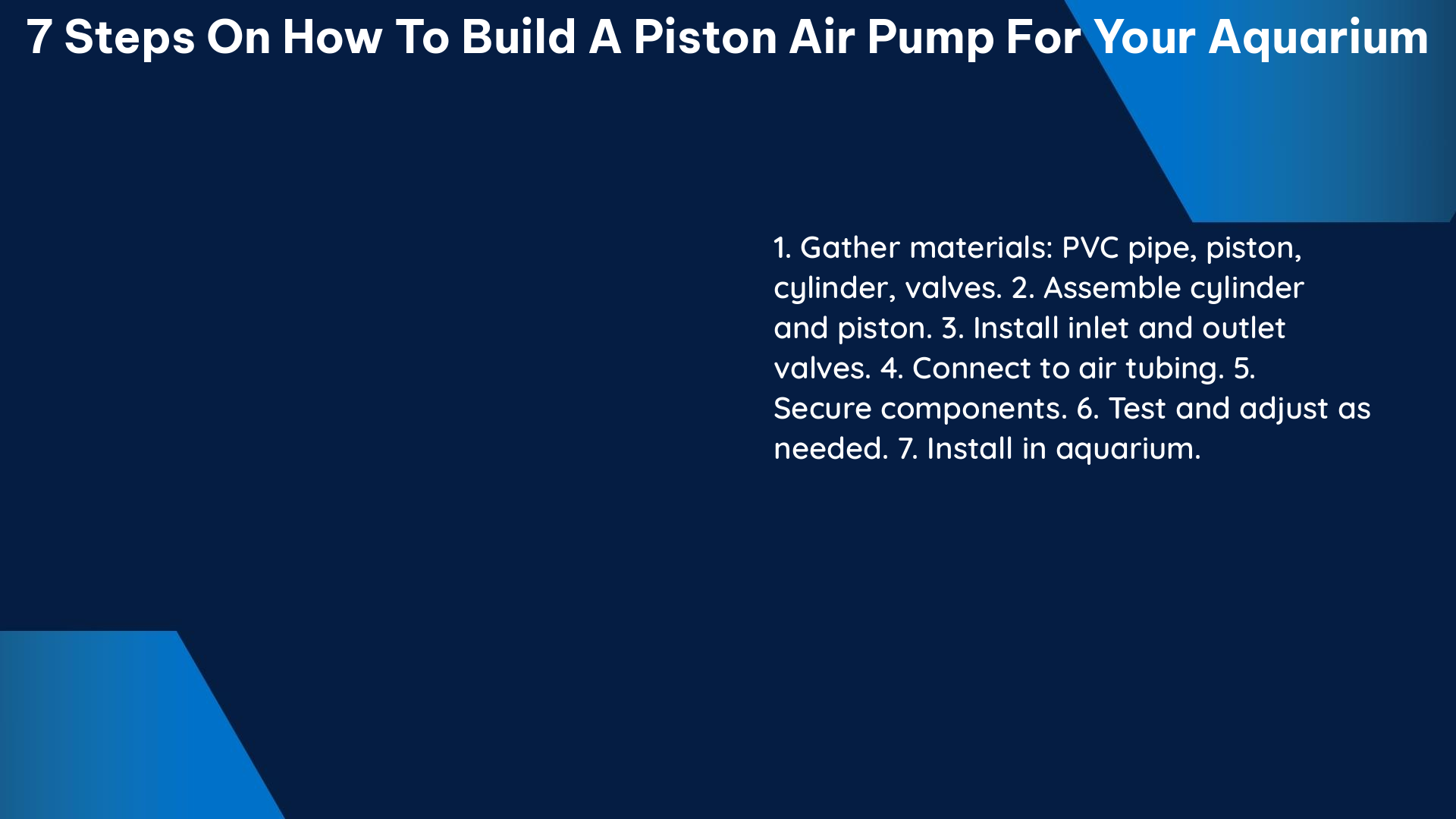Building a piston air pump for your aquarium can be a rewarding DIY project that involves several measurable and quantifiable steps. This comprehensive guide will walk you through the process, providing technical specifications and unique perspectives to help you create an efficient and reliable air pump for your aquarium.
Step 1: Gather Materials
To build a piston air pump, you will need the following materials:
- Piston: The piston’s diameter (d) is a crucial measurement. For a small aquarium pump, the piston diameter (d) can range from 10 to 25 millimeters (mm).
- Cylinder: The cylinder’s diameter (D) should be selected to match the piston diameter. A typical range for small aquarium pumps is 20 to 40 mm.
- Crankshaft: The crankshaft length (L) should be at least three times the piston’s diameter (d) to ensure efficient operation.
- Connecting Rod: The connecting rod length (l) should be approximately equal to the sum of the crankshaft length (L) and the cylinder diameter (D).
- Power Source: A 6V or 12V DC motor is often sufficient for powering a small aquarium pump.
- Tubing: The inner diameter (ID) of the tubing should match the outer diameter (OD) of the piston’s delivery port, typically ranging from 4 to 8 mm.
Step 2: Assemble the Crankshaft and Connecting Rod

The crankshaft and connecting rod are critical components that determine the pump’s efficiency and minimize vibration. The crankshaft length (L) should be at least three times the piston’s diameter (d) to provide enough leverage for the piston’s movement. The connecting rod length (l) should be approximately equal to the sum of the crankshaft length (L) and the cylinder diameter (D).
These dimensions can be calculated using the following formulas:
- Crankshaft Length (L): L ≥ 3 × d
- Connecting Rod Length (l): l ≈ L + D
Ensuring the proper dimensions for the crankshaft and connecting rod will help optimize the pump’s performance and reduce the risk of mechanical issues.
Step 3: Install the Piston in the Cylinder
The clearance between the piston and the cylinder (C) should be minimized to reduce air leakage. A typical clearance for small aquarium pumps is around 0.05 to 0.1 mm. This clearance can be adjusted by carefully selecting the piston and cylinder materials and using precision machining techniques.
To calculate the optimal clearance, you can use the following formula:
- Clearance (C): 0.05 mm ≤ C ≤ 0.1 mm
Maintaining a tight clearance between the piston and cylinder is crucial for maximizing the pump’s efficiency and air output.
Step 4: Connect the Power Source
The power source should provide enough torque to move the piston at the desired rate. For a small aquarium pump, a 6V or 12V DC motor is often sufficient. The motor’s speed (RPM) and the piston’s diameter (d) will determine the pump’s airflow rate (Q) in liters per minute (LPM). You can calculate the airflow rate using the following formula:
- Airflow Rate (Q): Q = (d^2 × π × RPM) / 4
By selecting the appropriate power source and understanding the relationship between the motor speed, piston diameter, and airflow rate, you can optimize the pump’s performance to meet the specific needs of your aquarium.
Step 5: Install the Air Delivery Tubing
The inner diameter (ID) of the tubing should match the outer diameter (OD) of the piston’s delivery port. For small aquarium pumps, a typical ID range is 4 to 8 mm. Using silicone tubing can help reduce friction and improve airflow.
To ensure a secure and efficient connection, the tubing’s ID should be slightly smaller than the piston’s OD. This will create a tight fit and minimize air leaks. Additionally, the tubing should be as short and straight as possible to minimize resistance and maximize airflow.
Step 6: Test the Airflow Rate
To measure the airflow rate of your piston air pump, you can use the displacement method. Place the air pump in a tank of water, cover the output with an inverted measuring cup filled with water, and run the pump for a known period. Divide the volume of water displaced by the time to get the airflow rate in LPM.
This testing process will allow you to verify the pump’s performance and ensure it meets the requirements of your aquarium setup.
Step 7: Adjust the Airflow Rate
If the measured airflow rate is too high or low, you can adjust the power source’s voltage or the piston’s stroke length to achieve the desired output. Changing the stroke length (SL) can be done by altering the crankshaft’s length (L) or the connecting rod’s length (l). The stroke length can be calculated using the following formula:
- Stroke Length (SL): SL = 2 × sqrt(L^2 – (d/2)^2) + 2 × sqrt(l^2 – (d/2)^2)
By fine-tuning the pump’s components and settings, you can optimize the airflow rate to perfectly match the needs of your aquarium.
Building a piston air pump for your aquarium is a rewarding DIY project that requires attention to detail and a solid understanding of the underlying principles. By following these seven steps and utilizing the provided technical specifications and formulas, you can create a reliable and efficient air pump that will enhance the health and well-being of your aquatic ecosystem.
References:
– Parker O-Ring Handbook
– Forum: Linear Piston Air Pump Minimum Number of Tanks
– Thread: Piston Air Pump Recommendations
– Reddit: Inexpensive Way to Measure Airflow Rate
– Instructables: Air Pump
